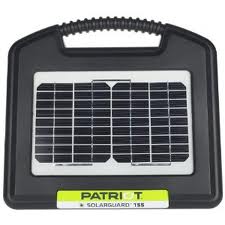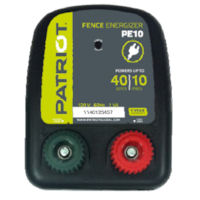We want to make sure you get the
most out of your electric fence system. The Patriot
fencing manual is a comprehensive guide to electric
fencing, covering the following topics:
- Choosing a charger
- Planning an electric fencing system
- Installing a ground system
- Constructing a temporary/permanent electric
fence
- Troubleshooting electric fencing problems
 Patriot catalog Patriot catalog
 Solar Charger Manual
Solar Charger Manual
-ROW_0.jpg) Dual Powered Manual
Dual Powered Manual
 PE & PB Manual
PE & PB Manual
.jpg) PBX Manual
PBX Manual
.jpg) PMX Manual
PMX Manual
1. Grounding
Most electric fence problems are caused by poor grounding.
Why? An electric fence is an electrical circuit. The electrical
current travels from the charger, down the fence line, through
the animal, along the earth to the ground system and back to the
charger. If the ground system is inadequate, the electrical
current is reduced and the animal receives a weaker shock.
Tips -
• The ground system should be at least 33' (10 m) away from
electric or telephone ground systems to avoid interference.
• Moist soil conducts electricity much better than dry soil.
If possible, locate the ground system in a boggy area. In dry
weather, wet the area around the ground system to keep the soil
moist.
• Make sure there are a sufficient number of ground rods. See
your charger’s user manual for recommendations. If in doubt, use
at least three ground rods. Use more ground rods if your soil
conditions are not ideal.
• Ground rods should be at least 6'6" (2 m) long. One long
ground rod works better than several short ground rods.
2. Testing your ground system
Test your ground system regularly to ensure you are getting
the most out of your electric fence.
1. Turn off the charger.
2. At least 330' (100 m) away from the charger, short circuit
the fence by laying several steel rods (or lengths of pipe)
against the fence. In dry or sandy soils, it may be necessary to
drive the rods up to 12" (30 cm) into the earth.
3. Turn on the charger.
Note: Do not short circuit a fence-return
(ground-wire-return) system by connecting the live wire to the
ground wire.
4. Use a digital voltmeter to measure the fence voltage. It
should read 2 kV or less. If not, add more ground rods.
5. Check the ground system by inserting the voltmeter’s
ground probe into the earth at the full extent of the lead, and
test the voltage on the last ground rod. The voltmeter reading
should be no more than 0.3 kV. If the reading is higher than
this, your ground system is insufficient. Add more ground rods,
or find a better location for your ground system.

3. Faults
Faults are caused when the electric current leaks away from
the fence down to the earth. This is often caused by grass,
weeds or overhanging branches touching the electric fence.
Broken insulators may cause a fault by allowing the electric
fence wire to touch the fence post. Check your fence regularly
using one of the procedures below.
4. Checking your fence
Using a fault finder is the quickest, most accurate way of
locating a fault in the fence. Starting at the leadout wire,
work your way along the fence taking readings at regular
intervals. A fault will show up as an abnormally high reading.
The electrical current flows towards a fault in the same way
that water flows towards a hole in a punctured hose. A sudden
change in current between one point and the next indicates a
fault between the two points.

It is also possible to check for faults using a digital
voltmeter. Isolate sections of the fence using cut-out switches
and check the voltage in each section.
An AM radio can be used to locate a fault. Tune the radio
between stations and drive or walk along of the fence. If the
fence is OK, there won't be any sound. When the radio gets near
a fault, you will hear clicking on the radio. As you get closer
to the fault, the clicking will get louder.
If the fault is caused by a faulty insulator, mark it with
non-metallic paint so you can locate it easily after you have
turned off the fence.
5. Joins
Electric fence wire should be joined using a knot that allows
the electrical current to pass through the wires. Here are some
recommended knots:
To join broken poliwire or politape, use a cigarettle lighter
to burn away the plastic yarn in order to expose the stainless
steel wire. Twist and join the wires together, then tie the
poliwire or politape in a knot. The electrical current can then
pass through the join. When inter-connecting fence wires at the
end of a strain, use joint clamps. Using these clamps, instead
of twisting wires together prevents arcing and greatly reduces
voltage loss.

6. Undergate connections
When bypassing gateways, ensure that live wires are protected
from damage caused by animal hooves, vehicles etc. Encase high
quality, double insulated underground cable in a polythene pipe
and bury at least 12 inches (30 cm) deep. Turn the ends of the
pipe down to keep water out.
7. Animal training
To train animals to respect electric fencing one method is to
use a small well-fenced holding paddock. Divide the holding
paddock using Politape and a Patriot charger. Introduce the
untrained livestock to the paddock. The animals will quickly
learn to avoid the electric fence barrier.
8. Choosing an electric fence charger
Make sure your electric fence charger meets the requirements
of your electric fence, refer to your Patriot installation
manual for guidance. This will vary depending on the type of
fence, the number of fence wires, how much vegetation is growing
around the fence and the climate. Remember, if you extend the
length of the fence by adding to the fence or subdividing it
with temporary fences, you need to make sure your charger is
powerful enough. If you use a more powerful charger, make sure
you increase the number of ground rods in the ground system.
9. RFI (Radio Frequency Interference)
Many farms suffer from RFI (Radio Frequency Interference.
This often results in poor radio reception and an annoying
ticking noise on the telephone line. Patriot chargers are fitted
with special components and advanced circuitry that
significantly reduces the levels of electrical emissions that
might otherwise affect adjacent electrical equipment. .
10. Mixing metals
Avoid using different metals in your electric fence. In damp
conditions, when an electric current passes through the
differing metals, electrolysis will occur. For example, using
stainless steel ground rods and an aluminium leadout wire will
cause problems. In a short space of time, the aluminium will
disintegrate. If possible, keep the wire joints above the soil
to improve airflow and reduce electrolysis. Seal the wire joints
with thick paint, epoxy or tar to keep moisture away from the
joint area. Use identical metals in your electric fence will
avoid problems with electrolysis altogether.
11. Getting a shock from a fence post or gate?
Sometimes, induction causes a strainer post or metal gate,
giving whoever touches it a nasty shock. To overcome this
problem, staple a piece of wire onto the strainer post to
interconnect all the fence wires. Bury the wire 3" (10 cm) into
the earth. This will carry the unwanted current down to the
earth. Because the interconnecting wire is positioned after the
insulators, you will not be compromising the quality of the
fence in any way.
|
